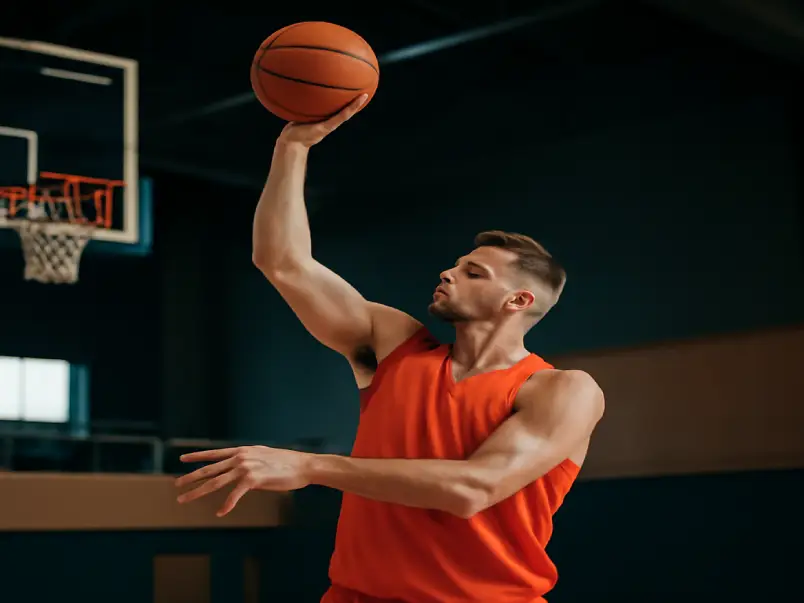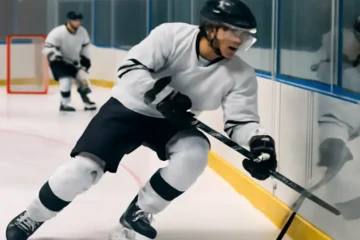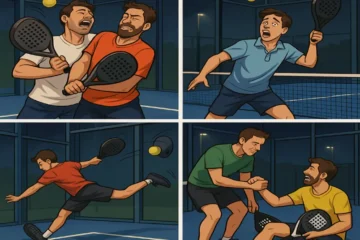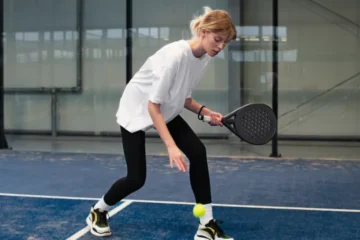In basketball, the ability to score in tight spaces is often the difference between a win and a loss. Whether you’re a post player, a guard driving the lane, or someone looking to add an unblockable weapon to your arsenal, the “Gancho” shot is a technique worth mastering. In this guide, we’ll explore the Gancho shot, breaking down its mechanics, footwork, practice drills, and in-game applications. Get ready to add this devastating move to your basketball repertoire!
Hook:
Imagine this scenario: you’re in the corner of the court, tightly marked by a defender. The lane is clogged, and there’s no clear passing option. To make matters worse, you’re running out of time, and shooting seems nearly impossible. This is where the Gancho shot comes in—a move designed for precisely this type of high-pressure situation.
What is a Gancho?
The Gancho is a unique, one-handed shot that utilizes a hooking motion, typically taken close to the basket. Often performed with the off-hand, it’s a move that allows a player to score over defenders in tight spaces, making it incredibly effective in the post, driving the lane, or facing pressure from taller players. It’s not a trick shot; it’s a practical, high-percentage weapon for players looking to break through tight defense.
Why it Matters:
In today’s basketball, having the ability to score in a variety of ways is crucial. The Gancho shot gives you an option that’s hard to defend and even harder to block, making it an essential tool for anyone who spends time in the paint or attacking the basket. It’s a move that adds versatility to your game, allowing you to break down defensive structures with finesse.
Brief Preview:
This guide will take you through the mechanics of the Gancho shot, the footwork required, the key strength and mobility prerequisites, and the drills needed to perfect it. By the end, you’ll have all the tools you need to start using this devastating shot in games.
Part 1: Deconstructing the Gancho – What Makes It Work
1.1. The Core Principle: Creating Space and Angle
The Gancho shot isn’t about power or force—it’s about finesse and using your body to create the necessary space and angle. At its core, the move is designed to allow the player to shield the ball from defenders with their body, making it nearly impossible for the defender to block the shot without fouling.
In essence, the Gancho is all about manipulating the space around you. The key to its success is the way the motion arcs over and around defenders, making it difficult for them to get a clean block. This hooking motion creates an unguardable trajectory, even against larger or more athletic defenders.
1.2. Anatomy of the Shot: The Two Main Types
There are two primary versions of the Gancho shot that players should master:
The Traditional Post Gancho: This version of the Gancho is often used when the player has their back to the basket, such as in the low post. It draws influence from the “skyhook” shot made famous by Kareem Abdul-Jabbar. The motion is smooth, with a high release point that’s hard to block even for taller defenders.
The Driving/Moving Gancho: This version of the shot is typically used when a player is driving toward the basket, often after executing a pick-and-roll or breaking down a defender off the dribble. The motion is more dynamic and requires quick thinking and excellent footwork, but it’s just as effective in creating space and scoring.
The Foundation – Prerequisites for a Deadly Gancho
2.1. Essential Strength & Mobility
Before you even think about mastering the Gancho, it’s important to have the foundational strength and mobility needed to execute the move effectively.
Wrist & Forearm Strength: One of the key components of the Gancho is a soft touch on the release. A strong wrist and forearm allow for more control, helping to guide the ball with precision and accuracy. Players who struggle with this often find that their Gancho shot lacks consistency or touch.
Core Stability: The ability to maintain balance while executing the Gancho is crucial. The move often requires an off-balance position, and core stability is what helps you maintain control of your body and the ball during the shot.
Shoulder Mobility: A smooth, fluid range of motion in the shoulders is critical for the Gancho. Since the shot involves an arc over the defender, limited shoulder mobility will prevent you from fully extending your arm and releasing the ball at the optimal point.
2.2. Mastery of Basic Footwork
Footwork is just as important as the shooting motion in the Gancho shot. To execute the move effectively, you need to have mastered basic basketball footwork principles.
The Pivot Foot: Establishing a strong pivot foot allows you to create separation and set up for the shot. Whether you’re facing the basket or working in the post, the ability to pivot and create space is key.
Establishing a Wide Base: A strong, wide base provides stability and balance during the execution of the Gancho. This is especially important when you’re executing the shot under pressure or with a defender on your hip.
The Step-by-Step Technique Breakdown
3.1. Footwork & Body Positioning
The first part of executing a successful Gancho shot is to establish your body position and create separation from the defender.
Creating the Seal: To do this, you’ll need to use your body to shield the ball from the defender. Position yourself so that your body is between the ball and the defender, creating a “seal.” This allows you to maintain possession and prepare for the shot.
The Pivot: The next step is to pivot. By pivoting around your planted foot, you can quickly face the basket and generate the necessary space for the shot. Proper pivoting helps you get your body into a position where you can quickly rise into the Gancho.
The Jump (or Step): The final part of the positioning is generating upward momentum. It’s crucial that you jump or step up into the shot, rather than leaning backward. This upward motion helps you avoid the defender’s hand and gives the shot more arc, making it harder to block.
3.2. The Shooting Motion
Now that you’ve established your footwork and body positioning, it’s time to execute the shooting motion.
The Grip & Ball Setup: To start the shot, cradle the ball in one hand, holding it lightly with your fingertips rather than palming it. Your off-hand should rest on the side of the ball, guiding it without taking control.
The Arm Path: The motion of your arm should follow a smooth, upward arc. Avoid pushing the ball sideways, which can lead to a poor shot or a turnover. Keep your shooting arm fluid, rising in a straight line over your head, like a hook shot.
The Release Point: Release the ball at the apex of your shot, just before the peak of your jump or the highest point of your body’s upward motion. This high release point makes it more difficult for defenders to block the shot.
The Follow-Through: The follow-through is crucial for backspin and touch. Imagine reaching for a cookie jar on a shelf above your head—this “cookie jar” motion ensures a smooth, controlled finish to the shot, helping the ball land softly on the rim or backboard.
3.3. Off-Hand vs. Strong Hand: When to Use Which
The advantage of using your off-hand for the Gancho is that it allows you to keep the ball further from the defender. For example, if you’re on the right block, using your left hand allows you to shield the ball and protect it from a potential block.
However, there are situations where using your strong hand is just as effective. The key is recognizing which hand to use based on the angle, the defender’s position, and the level of pressure.
Advanced Applications & Counters
Once you’ve mastered the basic Gancho, it’s time to learn how to use it in more advanced situations.
4.1. The “Dream Shake” Setup:
One of the most effective ways to create an opportunity for the Gancho is to first sell a fake. This is where the “Dream Shake” comes into play. By faking a move, you can get the defender off-balance and create the perfect window for the Gancho shot or an up-and-under.
4.2. The Fadeaway Gancho:
Against taller defenders, adding a slight fade to the Gancho can provide extra separation. By leaning away slightly as you release the shot, you increase your chances of scoring while making it even more difficult to block.
4.3. Gancho off the Glass:
Using the backboard for the Gancho can increase your margin for error. It also adds an extra element of unpredictability, as the defender may not be expecting the ball to bank off the glass.
4.4. Countering the Overplay:
If the defender anticipates the Gancho and plays you too aggressively, a quick spin back to the middle can leave them out of position and create a better angle for your shot.
Drills to Master the Gancho
Mastering the Gancho shot requires repetition and focused practice. Here are a few drills to help you get there:
Drill 1: The Mikan Gancho Drill
The Mikan drill helps you build muscle memory for the Gancho by focusing on footwork and touch. Use a low-post position to practice the Gancho from both sides of the basket.
Drill 2: Chair/Bag Drill
This drill is designed to simulate a defender by using a chair or bag as a stationary obstacle. Practice executing the Gancho while protecting the ball from the stationary defender.
Drill 3: The “Two-Spot” Gancho Drill
This drill is ideal for building muscle memory on both sides of the basket. Start from the left and right blocks, practicing the Gancho from each position.
Drill 4: Partner “Shell” Drill
This live, controlled drill involves a defender playing defense as you attempt to score with the Gancho. This will help you incorporate the move in game-like situations.
Integrating the Gancho into Your Game
Reading the Defender:
Identifying the perfect moment to deploy the Gancho is critical. Look for situations where the defender is overplaying your strong hand or when a smaller defender is guarding you.
Film Study:
Study players who have mastered the Gancho shot, such as Kareem Abdul-Jabbar, Magic Johnson, Luka Dončić, and Nikola Jokić. Watching how these players use the Gancho in different situations will give you valuable insights into when and how to use it.
Building Confidence:
Start using the Gancho in practice games, then gradually incorporate it into real games. The more confident you are with the move, the more effective it will become in high-pressure situations.
Conclusion
The Gancho shot is more than just a flashy move; it’s a high-IQ, high-percentage shot that can be a game-changer in tight spaces. By focusing on the mechanics, footwork, and drills outlined in this guide, you can develop a reliable, unblockable weapon that will elevate your game. With dedication and consistent practice, the Gancho shot can become a key part of your offensive arsenal.
FAQs
What is a Gancho shot in basketball?
A Gancho is a one-handed shot that uses a hooking motion, typically taken close to the basket. It’s performed with the off-hand and is often used by post players, guards driving the lane, or anyone looking to score in tight spaces. The shot is effective because it’s difficult for defenders to block due to its high release point and smooth arc.
How do I perform the Gancho shot?
To perform the Gancho shot, you need to focus on proper footwork, body positioning, and shooting mechanics. Begin by establishing a seal with your body, pivoting to face the basket, and generating upward momentum. Your shooting hand should create a smooth, upward arc while releasing the ball at the apex for maximum height and accuracy. The follow-through should resemble a “cookie jar” motion for backspin.
When should I use the Gancho shot in a game?
The Gancho shot is ideal when you’re in a tight spot with a defender blocking your path to the basket. It’s particularly useful when you’re in the post, driving to the basket, or when facing taller defenders. Use the Gancho when you need a quick, high-percentage shot that’s hard to block.
What are the benefits of using the Gancho shot?
The Gancho shot allows you to score in tight spaces with a high level of control and accuracy. It’s a difficult shot to block due to its high release point, making it a valuable tool for players looking to score in the paint or when facing aggressive defenders. Additionally, it adds versatility to your offensive game.
How can I improve my Gancho shot?
Improving your Gancho shot requires focused practice on key fundamentals, including footwork, body positioning, and wrist strength. Drills such as the Mikan Gancho drill, chair/bag drill, and partner “Shell” drill will help you build muscle memory. Consistency and repetition are key to mastering the shot.
Can the Gancho shot be used with either hand?
Yes, the Gancho can be performed with either hand. The off-hand is often used to create separation from the defender, while the strong hand can also be effective depending on the situation. Knowing when to use each hand is crucial for maximizing the shot’s effectiveness.
What are some variations of the Gancho shot?
Some advanced variations include the Fadeaway Gancho, which adds a slight fade for extra separation from taller defenders, and the Gancho off the glass, which uses the backboard to increase your margin for error. These variations offer more options for different game situations.




